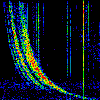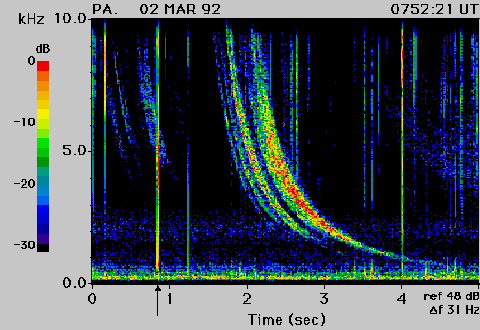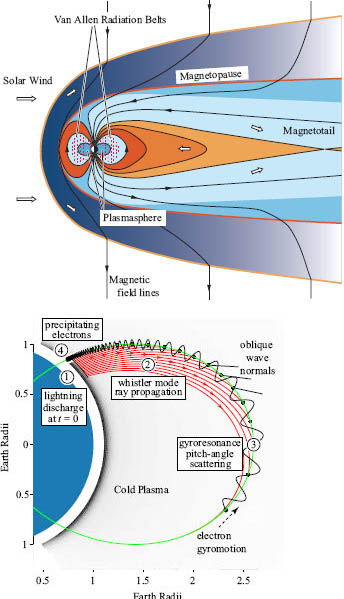The Stanford VLF Group studies a number of science questions related to the occurrence and propagation of very low frequency (VLF) radio waves in the Earth’s low altitude (0-1000 km) and high altitude (1000-100,000 km) environment.
The Stanford VLF Group studies a number of science questions related to the occurrence and propagation of very low frequency (VLF) radio waves in the Earth’s low altitude (0-1000 km) and high altitude (1000-100,000 km) environment. Among these are:
What is the nature of whistler-mode propagation through the Earth’s magnetized plasma envelope (the magnetosphere) from lightning sources on the ground in one hemisphere to receivers in the opposite hemisphere?
In the 1950s and 1960s, the ground-to-ground interhemispheric propagation of lightning-generated whistlers came to be relatively well understood and whistlers came into regular use as remote probes of the radial distribution of electron density in the Earth’s geomagnetic equatorial plane. Through whistler data recorded by Stanford at spaced stations in the northern hemisphere and in Antarctica, the plasmapause was discovered, a sharp drop in electron density at several Earth radii geocentric distance that forms the outer boundary of a dense torus-like belt called the plasmasphere. An example of a whistler that propagated along geomagnetic-field-aligned paths from a lightning flash in the northern hemisphere to Palmer Station, Antarctica, is shown in Figure 1. The whistler paths in this case extended at the equator to geocentric distances of 2-2.5 Earth radii. The event is presented in coordinates of frequency (0-10 kHz) vs time in seconds, with intensity indicated by the darkness of the display. Vertical lines indicate impulsive, minimally dispersed energy from lightning flashes (sferics) that propagated in the Earth-ionosphere waveguide to the receiver. An arrow indicates the sferic radiated by the lightning flash that launched the whistler.
What is the nature of whistler-mode propagation between ground sources and various points in the Earth’s ionosphere and overlying magnetosphere?
In the 1960s it was realized that a significant fraction of the wave energy incident from below on the Earth’s ionosphere propagates in an unducted mode, with wave normals reaching large angles with respect to the direction of the geomagnetic field (unlike the ducted case) and ray paths that may cross and recross the magnetic equatorial plane as the increasingly dispersed waves move back and forth between so called “magnetospheric reflection” points. The remarkable OGO satellite series of the 1960s revealed a wide variety of natural plasma wave activity in space and stimulated theorists to consider the role of wave-particle energy and momentum exchange in affecting the distribution of geomagnetically trapped particles in the magnetosphere. In the 1980s, innovative approaches were taken to analyzing the distribution of waves incident upon a satellite, and through ray tracing and other analyses of the wave data, new insights were obtained about the origin of received waves and about the properties of the medium through which they traveled.
What is the nature of the interactions between whistler-mode waves and the hot plasma of the Earth’s radiation belts?
In the 1960s there began a remarkable series of experiments involving controlled injection of whistler-mode signals into the magnetosphere and study of the mechanism by which the spectra of the waves were apparently altered by the hot plasma of the magnetosphere. This work was initially dependent upon signals from existing communication and navigation transmitters, but advanced rapidly in the 1970s and 1980s with the operation of experimental VLF transmitters at Siple Station, Antarctica and receivers in the magnetic conjugate region in Canada. The large and still growing body of work on the Siple experiments has provided new understanding of the manner in which an essentially collisionless magnetized cosmic plasma may preferentially amplify coherent waves, and in general places us on the threshold of an era when important properties of both the hot and cold components of the magnetospheric plasma may be probed from the ground.
What kinds of perturbations of the Earth’s plasma environment and of radio communication paths occur as the result of injection of waves into the Earth’s plasma environment?
One of the geophysical consequences of wave-particle interactions in the magnetosphere is burst scattering of trapped energetic particles by waves. Those particles whose trapped orbits carry them to relatively low altitudes may be scattered so as to reach still greater atmospheric depths and be precipitated, producing in the process optical emissions, additional ionization, and x-rays. Since the 1970s much attention has been devoted to the circumstances under which, and the mechanisms by which, such ionospheric perturbations may be induced by the magnetospheric propagation of lightning-generated whistlers, man-made signals and natural emissions. One of the most sensitive and versatile tools for detection of the transient ionospheric effects at middle and lower latitudes is the subionospherically propagating VLF signal, use of which has advanced rapidly in recent years as networks of receivers have been operated on a campaign basis to “map” ionospheric perturbations. Through such mapping and interpretive work it is hoped to assess the apparently significant role of burst scattering by whistler-mode waves as a loss process for the energetic electrons injected into the magnetosphere during periods of solar-induced disturbance.
How does auroral particle precipitation into the Earth’s ionosphere affect the properties of radio signals propagating in the spherical waveguide formed by the Earth and the ionosphere?
Subionospheric VLF signals crossing the high latitude belt of auroral activity known as the auroral oval tend to exhibit irregular variations in amplitude and phase and have lower average signal levels than would be expected on paths limited to subauroral latitudes. The strong response of VLF signals to auroral particle precipitation has been used to identify the location and movements of the edge of the dynamic auroral oval as the oval moves equatorward or retreats poleward and thus encroaches upon or moves away from a network of predominantly east-west signal paths. Application of a VLF signal method to detection of the edge of the auroral oval is being studied as a practical means of identifying (and warning against) circumstances under which damaging currents might be induced in communication and power grids by strong auroral currents.
How does the process of thundercloud electrification affect the ionosphere and radio communications that depend upon the reflection properties of the nearby ionosphere?
Studies of ionospheric perturbations induced by propagating waves led in the 1980s to recognition of a class of prompt or fast ionospheric changes that could not be ascribed to a process of scattering by waves propagating along high altitude magnetospheric paths. Instead, they were interpreted as the result of some type of more or less direct coupling between the lower ionosphere and the fields associated with a nearby lightning flash. This realization, augmented by reported observations of lightning extending upward from thundercloud areas, led to the identification of direct ionosphere heating by VLF communication transmitters and by natural lightning. This general area of research is now producing important new understanding of the stages by which, and the extent to which, the overlying ionosphere is modified by lightning events of various intensities and charge configurations.


